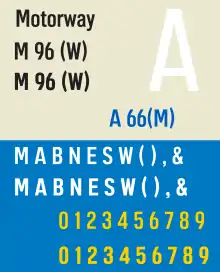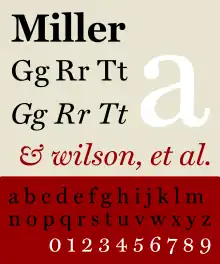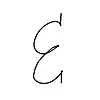Ampersand
The ampersand, also known as the and sign, is the logogram &, representing the conjunction "and". It originated as a ligature of the letters et—Latin for "and".[1]
| Ampersand | |
|---|---|
| & | |
| ﹠, ⅋, &, 🙰, 🙱, 🙲, 🙳, 🙴, 🙵 | |
| Usage | |
| Writing system | Latin script |
| Type | Logographic and Ideographic |
| Language of origin | Latin language |
| Unicode codepoint | U+0026 |
| Alphabetical position | (27) |
| History | |
| Development | |
| Time period | c. 100 CE to present |
| Descendants | • ⅋ |
| Sisters | Greek letter ϗ (ligature of κ, α and ι similarly to &) Armenian letter և (ligature of ե and ւ, pronounced /jɛv/; եւ is the Armenian word for "and"); Sindhi letter, ۽ |
| Transliteration equivalents | plus sign, + |
| Variations | ﹠, ⅋, &, 🙰, 🙱, 🙲, 🙳, 🙴, 🙵 |
| Other | |
| Other letters commonly used with | &C (etC) |
| Writing direction | Left-to-Right |
Etymology
The term ampersand is a corruption of and (&) per se and, which literally means "(the character) & by itself (is the word) and". The symbol & is derived from the ligature of ET or et, which is the Latin word for "and".
— Geoffrey Glaister, Glossary of the Book[2]
Traditionally in English, when spelling aloud, any letter that could also be used as a word in itself ("A", "I", and, "O") was referred to by the Latin expression per se ('by itself'), as in "per se A" or "A per se A".[3][4][5] The character &, when used by itself as opposed to more extended forms such as &c., was similarly referred to as "and per se and".[6][7] This last phrase was routinely slurred to "ampersand" and the term had entered common English usage by 1837.[4][8][9]
It has been falsely claimed that André-Marie Ampère used the symbol in his widely read publications and that people began calling the new shape "Ampère's and".[10]
History
 Evolution of the ampersand.[11] Figures 1 through 6
Evolution of the ampersand.[11] Figures 1 through 6 The modern ampersand is virtually identical to that of the Carolingian minuscule. The italic ampersand, to the right, is originally a later et-ligature
The modern ampersand is virtually identical to that of the Carolingian minuscule. The italic ampersand, to the right, is originally a later et-ligature Et ligature in Insular script
Et ligature in Insular script Example of ampersand based on a crossed epsilon, as might be handwritten
Example of ampersand based on a crossed epsilon, as might be handwritten Capital letters ampersand on a coin of 1 Makuta of 1814, Portuguese Angola.
Capital letters ampersand on a coin of 1 Makuta of 1814, Portuguese Angola.
The ampersand can be traced back to the 1st century A.D. and the old Roman cursive, in which the letters E and T occasionally were written together to form a ligature (Evolution of the ampersand – figure 1). In the later and more flowing New Roman Cursive, ligatures of all kinds were extremely common; figures 2 and 3 from the middle of 4th century are examples of how the et-ligature could look in this script. During the later development of the Latin script leading up to Carolingian minuscule (9th century) the use of ligatures in general diminished. The et-ligature, however, continued to be used and gradually became more stylized and less revealing of its origin (figures 4–6).[11]
The modern italic type ampersand is a kind of "et" ligature that goes back to the cursive scripts developed during the Renaissance. After the advent of printing in Europe in 1455, printers made extensive use of both the italic and Roman ampersands. Since the ampersand's roots go back to Roman times, many languages that use a variation of the Latin alphabet make use of it.
The ampersand often appeared as a character at the end of the Latin alphabet, as for example in Byrhtferð's list of letters from 1011.[12] Similarly, & was regarded as the 27th letter of the English alphabet, as taught to children in the US and elsewhere. An example may be seen in M. B. Moore's 1863 book The Dixie Primer, for the Little Folks.[13] In her 1859 novel Adam Bede, George Eliot refers to this when she makes Jacob Storey say: "He thought it [Z] had only been put to finish off th' alphabet like; though ampusand would ha' done as well, for what he could see."[14] The popular nursery rhyme Apple Pie ABC finishes with the lines "X, Y, Z, and ampersand, All wished for a piece in hand".
Similar characters

In Irish and Scottish Gaelic, the character ⁊ is used in place of the ampersand. This character is a survival of Tironian notes, a medieval shorthand system. This character is known as the Tironian Et in English, the agus in Irish, and the agusan in Scottish Gaelic.
The logical conjunction symbol, ∧, is often pronounced "and," but is not related to the ampersand.
Writing the ampersand
In everyday handwriting, the ampersand is sometimes simplified in design as a large lowercase epsilon Ɛ or a reversed numeral 3, superimposed by a vertical line.[15] The ampersand is also sometimes shown as an epsilon with a vertical line above and below it or a dot above and below it.[15]
The plus sign + (itself based on an et-ligature[16]) is often informally used in place of an ampersand, sometimes with an added loop and resembling ɬ.
Usage
Ampersands are commonly seen in business names formed from a partnership of two or more people, such as Johnson & Johnson, Dolce & Gabbana, Marks & Spencer, and Tiffany & Co., as well as some abbreviations containing the word and, such as AT&T (American Telephone and Telegraph), A&P (supermarkets), P&O (originally "Peninsular and Oriental", shipping and logistics company), R&D (research and development), D&B (drum and bass), D&D (Dungeons & Dragons), R&B (rhythm and blues), B&B (bed and breakfast), and P&L (profit and loss).[17][18]
In film credits for stories, screenplays, etc., & indicates a closer collaboration than and. The ampersand is used by the Writers Guild of America to denote two writers collaborating on a specific script, rather than one writer rewriting another's work. In screenplays, two authors joined with & collaborated on the script, while two authors joined with and worked on the script at different times and may not have consulted each other at all.[19][20] In the latter case, they both contributed enough significant material to the screenplay to receive credit but did not work together. As a result, both & and and may appear in the same credit, as appropriate to how the writing proceeded.
In APA style, the ampersand is used when citing sources in text such as (Jones & Jones, 2005). In the list of references, an ampersand precedes the last author's name when there is more than one author.[21] (This does not apply to MLA style, which calls for the "and" to be spelled.[22])
The phrase et cetera ("and so forth"), usually written as etc. can be abbreviated &c. representing the combination et + c(etera).
The ampersand can be used to indicate that the "and" in a listed item is a part of the item's name and not a separator (e.g. "Rock, pop, rhythm & blues and hip hop").
The ampersand may still be used as an abbreviation for "and" in informal writing regardless of how "and" is used.
Computing
Encoding and display
The character in Unicode is U+0026 & AMPERSAND (&, &); this is inherited from the same value in ASCII.
Apart from this, Unicode also has the following variants:
- U+FE60 ﹠ SMALL AMPERSAND (fullwidth CJK ideograph for East Asian typography)
- U+FF06 & FULLWIDTH AMPERSAND (in block Halfwidth and Fullwidth Forms)
- U+214B ⅋ TURNED AMPERSAND (in block Letterlike Symbols)
- U+1F670 🙰 SCRIPT LIGATURE ET ORNAMENT
- U+1F671 🙱 HEAVY SCRIPT LIGATURE ET ORNAMENT
- U+1F672 🙲 LIGATURE OPEN ET ORNAMENT
- U+1F673 🙳 HEAVY LIGATURE OPEN ET ORNAMENT
- U+1F674 🙴 HEAVY AMPERSAND ORNAMENT
- U+1F675 🙵 SWASH AMPERSAND ORNAMENT
The last six of these are carryovers from the Wingdings fonts, and are meant only for backward compatibility with those fonts.
On the QWERTY keyboard layout, the ampersand is ⇧ Shift+7. It is almost always available on keyboard layouts, sometimes on ⇧ Shift+6 or ⇧ Shift+8. On the AZERTY keyboard layout, & is an unmodified keystroke, positioned above A.
In URLs, the ampersand must be replaced by %26 when representing a string character to avoid interpretation as a URL syntax character.
Programming languages
In the 20th century, following the development of formal logic, the ampersand became a commonly used logical notation for the binary operator or sentential connective AND. This usage was adopted in computing.
Many languages with syntax derived from C, including C++, Perl,[23] and more differentiate between:
&for bitwise AND.(4 & 2)is zero,(4 & 5)is 4.&&for short-circuit logical AND.(4 && 2)is true.
In C, C++,[24] and Go,[25] a prefix & is a unary operator denoting the address in memory of the argument, e.g. &x, &func, &a[3].
In C++ and PHP, unary prefix & before a formal parameter of a function denotes pass-by-reference.[26][27]
In Pascal, the & as the first character of an identifier prevents the compiler from treating it as a keyword, thus escaping it.
In Fortran, the ampersand forces the compiler to treat two lines as one. This is accomplished by placing an ampersand at the end of the first line and at the beginning of the second line.[28]
In many implementations of ALGOL 60 the ampersand denotes the tens exponent of a real number.
In Common Lisp, the ampersand is the prefix for lambda list keywords.[29]
Ampersand is the string concatenation operator in many BASIC dialects, AppleScript, Lingo, HyperTalk, and FileMaker. In Ada it applies to all one-dimensional arrays, not just strings.
BASIC-PLUS on the DEC PDP-11 uses the ampersand as a short form of the verb PRINT.
Applesoft BASIC used the ampersand as an internal command, not intended to be used for general programming, that invoked a machine language program in the computer's ROM.
In some versions of BASIC, unary suffix & denotes a variable is of type long, or 32 bits in length.
The ampersand was occasionally used as a prefix to denote a hexadecimal number, such as &FF for decimal 255, for instance in BBC BASIC. (The modern convention is to use "x" as a prefix to denote hexadecimal, thus xFF.) Some other languages, such as the Monitor built into ROM on the Commodore 128, used it to indicate octal instead, a convention that spread throughout the Commodore community and is now used in the VICE emulator.[30]
In MySQL, & has dual roles. As well as a logical AND, it additionally serves as the bitwise operator of an intersection between elements.[31]
Dyalog APL uses ampersand similarly to Unix shells, spawning a separate green thread upon application of a function.
In more recent years, the ampersand has made its way into the Haskell standard library, representing flipped function application: x & f means the same thing as f x.
Perl uses the ampersand as a sigil to refer to subroutines:
- In Perl 4 and earlier, it was effectively required to call user-defined subroutines[32]
- In Perl 5, it can still be used to modify the way user-defined subroutines are called[33]
- In Raku (formerly known as Perl 6), the ampersand sigil is only used when referring to a subroutine as an object, never when calling it[34]
In MASM 80x86 Assembly Language, & is the Substitution Operator, which tells the assembler to replace a macro parameter or text macro name with its actual value.[35]
Ampersand is the name of a reactive programming language, which uses relation algebra to specify information systems.[36]
Text markup
In SGML, XML, and HTML, the ampersand is used to introduce an SGML entity, such as (for non-breaking space) or α (for the Greek letter α). The HTML and XML encoding for the ampersand character is the entity &.[37] This can create a problem known as delimiter collision when converting text into one of these markup languages. For instance, when putting URLs or other material containing ampersands into XML format files such as RSS files the & must be replaced with & or they are considered not well formed, and computers will be unable to read the files correctly. SGML derived the use from IBM Generalized Markup Language, which was one of many IBM-mainframe languages to use the ampersand to signal a text substitution, eventually going back to System/360 macro assembly language.
In the plain TeX markup language, the ampersand is used to mark tabstops. The ampersand itself can be applied in TeX with \&. The Computer Modern fonts replace it with an "E.T." symbol in the cmti# (text italic) fonts, so it can be entered as {\it\&} in running text when using the default (Computer Modern) fonts.[38]
In Microsoft Windows menus, labels, and other captions, the ampersand is used to denote the next letter as a keyboard shortcut (called an "Access key" by Microsoft).[39] For instance setting a button label to "&Print" makes it display as Print and for Alt+P to be a shortcut equivalent to pressing that button. A double ampersand is needed in order to display a real ampersand. This convention originated in the first WIN32 api, and is used in Windows Forms,[39] (but not WPF, which uses underscore _ for this purpose) and is also copied into many other toolkits on multiple operating systems. Sometimes this causes problems similar to other programs that fail to sanitize markup from user input, for instance Navision databases have trouble if this character in either "Text" or "Code" fields.
Unix shells
Some Unix shells use the ampersand as a metacharacter:
Some Unix shells, like the POSIX standard sh shell, use an ampersand to execute a process in the background and to duplicate file descriptors.
- In Bash, the ampersand can separate words, control the command history, duplicate file descriptors, perform logical operations, control jobs, and participate in regular expressions.[40]
Web standards
The generic URL (Uniform Resource Locator) syntax allows for a query string to be appended to a file name in a web address so that additional information can be passed to a script; the question mark, or query mark, ?, is used to indicate the start of a query string.[41] A query string is usually made up of a number of different name–value pairs, each separated by the ampersand symbol, &. For example, http://www.example.org/list.php?order=ascending&year=2023.
Typeface samples
 Noto Sans - Script Ligature Et Ornament
Noto Sans - Script Ligature Et Ornament Noto Sans - Ligature Open Et Ornament
Noto Sans - Ligature Open Et Ornament The ampersand character, in the OCR-A font
The ampersand character, in the OCR-A font.svg.png.webp) Italic ampersand from a 1735 book (redrawn)
Italic ampersand from a 1735 book (redrawn).jpg.webp) Albertus (typeface) sampler (1936). Two styles of ampersand are shown.
Albertus (typeface) sampler (1936). Two styles of ampersand are shown. Motorway (typeface) sampler (1958)
Motorway (typeface) sampler (1958) Miller (typeface) sampler (1997)
Miller (typeface) sampler (1997)
See also
References
- "The Ampersand & More" Archived 4 July 2015 at the Wayback Machine with Kory Stamper, part of the "Ask the Editor" video series at Merriam-Webster.com
- Glaister, Geoffrey Ashall (1960). Glossary of the Book. London: George Allen & Unwin. cited in Caflisch, Max. "The ampersand". Adobe Fonts. Adobe Systems. Archived from the original on 13 January 2013. Retrieved 23 December 2012.
- Nares, Robert (2011) [first published 1822]. A Glossary. Cambridge University Press. p. 1. ISBN 9781108035996. Archived from the original on 3 January 2014. Retrieved 1 May 2013.
- "The ampersand". word-detective. Archived from the original on 8 May 2008.
- "The Ampersand & More". merriam-webster. Archived from the original on 28 March 2014. Retrieved 14 November 2012.
- Ainger, Alfred (2 December 1871). "Amperzand". Notes and Queries. 4. 8: 468.
- Harper, Douglas R. (20 September 2022). "ampersand". Online Etymology Dictionary. Retrieved 5 August 2023.
- "What character was removed from the alphabet but is still used every day?". The Hot Word. Dictionary.com. 2 September 2011. Archived from the original on 27 September 2011. Retrieved 4 September 2011.
- "ampersand". Oxford English Dictionary (Online ed.). Oxford University Press. (Subscription or participating institution membership required.) (subscription required)
- For examples of this misunderstanding, see Jessie Bedford, Elizabeth Godfrey: English Children in the Olden Time, page 22 Archived 20 February 2017 at the Wayback Machine. Methuen & co, 1907, p. 22; Harry Alfred Long: Personal and Family Names, page 98 Archived 19 February 2017 at the Wayback Machine. Hamilton, Adams & co, 1883.
- Jan Tschichold: "Formenwandlung der et-Zeichen."
- Everson, Michael; Sigurðsson, Baldur; Málstöð, Íslensk (7 June 1994). "On the status of the Latin letter þorn and of its sorting order". Evertype. Archived from the original on 24 September 2018. Retrieved 16 November 2010.
- "The Dixie Primer, for the Little Folks". Branson, Farrar & Co., Raleigh NC. Archived from the original on 5 May 2011. Retrieved 16 November 2010.
- Eliot, George. "Chapter XXI". Adam Bede. Archived from the original on 24 September 2015. Retrieved 16 November 2010 – via Project Gutenberg.
- "A Visual Guide to the Ampersand (Infographic)". Six Revisions. 13 October 2011. Archived from the original on 15 November 2017. Retrieved 24 June 2017.
- Cajori, Florian (1928). "Origin and meanings of the signs + and −". A History of Mathematical Notations, Vol. 1. The Open Court Company, Publishers.
- "Ampersands". ChicagoManualOfStyle.org. Archived from the original on 2 April 2015. Retrieved 1 April 2015.
- Fiske, Robert Hartwell (November 2011). Robert Hartwell Fiske's Dictionary of Unendurable English: A Compendium of Mistakes in Grammar, Usage, and Spelling with Commentary on Lexicographers. Simon and Schuster. ISBN 9781451651348. Archived from the original on 20 February 2017. Retrieved 23 September 2016.
- "Frequently Asked Questions". Writers Guild of America. Archived from the original on 26 January 2022. Retrieved 24 September 2018.
- Trottier, David (2010). The Screenwriter's Bible (5th expanded & updated ed.). Silman-James Press. p. 142. ISBN 978-1-935247-02-9.
- "Purdue OWL: APA Formatting and Style Guide". Owl.english.purdue.edu. Archived from the original on 30 April 2012. Retrieved 8 May 2012.
- "Purdue OWL: MLA Formatting and Style Guide". Owl.english.purdue.edu. 9 February 2012. Archived from the original on 12 May 2012. Retrieved 8 May 2012.
- "perlop – Perl operators and precedence". Archived from the original on 30 May 2007. Retrieved 31 May 2007.
- "Pointers - C++ Tutorials". Archived from the original on 17 June 2021. Retrieved 18 June 2021.
- "The Go Programming Language Specification". Archived from the original on 13 May 2021. Retrieved 18 June 2021.
- "Pass by reference (C++ only)". www.ibm.com. Archived from the original on 23 October 2021. Retrieved 23 October 2021.
- "PHP: Passing by Reference - Manual". www.php.net. Archived from the original on 23 October 2021. Retrieved 23 October 2021.
- "Fortran continuation lines". pages.mtu.edu. Archived from the original on 12 September 2017. Retrieved 12 September 2017.
- "3.4.1 Ordinary Lambda Lists". Common Lisp – Hyper Spec. Lisp Works. Archived from the original on 11 November 2010. Retrieved 30 August 2010.
- "Commodore 128 Machine Language. Part 2". www.atarimagazines.com. Archived from the original on 29 November 2020. Retrieved 1 March 2021.
- "MySQL :: MySQL 8.0 Reference Manual :: 12.4 Operators". dev.mysql.com. Archived from the original on 23 October 2021. Retrieved 23 October 2021.
- "PERL – Subroutines". Archived from the original on 21 October 2020. Retrieved 29 August 2019.
- "What is the point of the & / ampersand sigil for function refs?". PerlMonks. Archived from the original on 27 September 2007. Retrieved 31 May 2007.
- "Exegesis 6". Perl.com. 7 July 2003. Archived from the original on 18 August 2007. Retrieved 31 May 2007.
- Microsoft MASM Version 6.1 Programmer's Guide
- "Ampersand". GitHub. Archived from the original on 31 May 2019. Retrieved 5 March 2019.
- "HTML Compatibility Guidelines". World Wide Web Consortium. Archived from the original on 14 April 2006. Retrieved 19 April 2006.
- Knuth, Donald (1986). The TeXbook. Addison-Wesley. p. 428. ISBN 0-201-13447-0.
- How to: Create Access Keys for Windows Forms Controls Archived 3 October 2009 at the Wayback Machine, from msdn.microsoft.com
- Fox, Brian; Ramey, Chet (28 September 2006). "UNIX Manual page: bash – GNU Bourne-Again SHell" (manpage). Archived from the original on 2 December 2013. Retrieved 20 June 2009.
- ""Ampersands in URI attribute values"". Archived from the original on 7 June 2007. Retrieved 7 June 2007.
External links
- "The History of 'Ampersand'". Merriam-Webster. Retrieved 27 July 2022.
- The Hot Word at Dictionary.com: How ampersand came from a misunderstanding
- "Ask the Editor: Ampersand", video at Merriam-Webster.com (2:01). Retrieved 2013-10-18 Archived 19 October 2013 at the Wayback Machine
- Font of 52 ampersands, designed by Frederic Goudy


